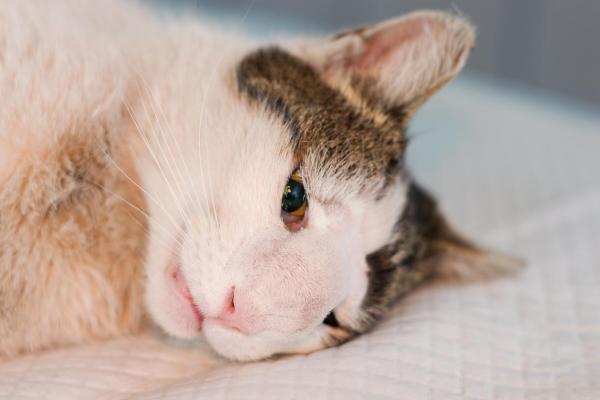
Petting and brushing our cat helps to condition their coat, strengthen our bond and provide all-important affection. It also provides the opportunity to check their skin for any abnormalities. Sometimes inflammation and lumps can be seen when we look at the cat, others are only detectable when we feel them. As there are various types of lumps in cats which can develop under their skin, we need to look at their different qualities to help determine their cause. We need to ask whether they are hard or soft, whether they move when touched, where they present on the body and more.
At AnimalWised, we look at why my cat has lumps under their skin. We look at the various types of feline skin lumps and understand their causes and treatment.
Types of lumps under a cat's skin
Cats can develop lumps which present in various ways. Some can be soft fatty lumps which have a lot of give when touched. Others can be very hard and won't move much under their skin. These different qualities are very important for a veterinarian as they can help to determine whether the lump under the cat's skin is benign or malignant.
Kittens often develop temporary lumps under their skin which are usually benign lipomas (fatty lumps). They can often be the result of a fall or a blow when playing with their siblings or exploring. Older cats can also develop benign lumps when they age. However, they are at a greater risk of cancers and other malignant processes. When many lumps form, it can even be a sign of metastatic tumors.
Generally, the lumps under your cat's skin will be one of the following:
- Fatty lumps: also called lipomas, they consist mesenchymal stem cell masses which differentiate into an overgrowth of fat cells (adipocytes). These subcutaneous lumps are firm, but soft and spongy. They can be singular or multiple.
- Benign neoplasms: neoplasia is a general process which causes too many cells to reproduce. When this happens, they grow into a solid mass which forms a tumor. These can be benign which usually present as cysts. They may be removed or drained, but in many cases the cat can live a normal life with the lumps present under their skin.
- Malignant tumors: unfortunately, neoplasia can also form malignant tumors due to cancer. Some different types of tumor-causing skin cancers in cats include basal cell carcinoma, squamous cell carcinoma , fibrosarcoma and mastocytoma.
- Inflammatory lumps: in some inflammatory or allergic processes, nodules or lumps can occur on the skin of cats. This happens when the cat suffers from feline eosinophilic granuloma complex, panniculitis or urticaria. Trauma to the skin can also result in inflammation which usually goes down of its own accord.
- Infectious lumps: nodules and lumps under the skin can be caused by infection. These can form abscesses which either remain under the skin or break through and cause open wounds. Abscesses can be due to pus accumulating in order to fight an infection, usually from a bacterial origin. These can be due to mycobacteria such as Nocardia or Actinomyces in the case of contaminated wounds, or fungal infections such as Cryptococcus, dermatophytes or opportunistic saprophytic fungi. Infectious growths in the nose are usually due to fungal granulomas such as those produced by the Alternaria fungus.
- Hematoma: often due to trauma, blood can collect under the cat's skin and cause a lump. This can be minor or very serious, depending on the extent of the internal bleeding.
- Cystic Lumps: a type of benign neoplasm, cysts can cause lumps to form under the cat's skin. Cysts in cats differ from previous growths or masses in that they are generally fluid-filled sacs or cavities. They can also contain air. They are usually very soft to the touch and are not related to malignant processes.
Since location of the inflammation is so important, take a look at reasons why your cat has a lump on their neck.
Symptoms associated with lumps in cats
When we find a lump under our cat's skin, we need to determine if they developed from a systemic or organic disease. We also need to monitor its size as a rapid growing lump may be cause for a veterinary emergency, as is the case with many hematomas. We also need to determine if the cat has been in an accident, fight or any other situation where they can receive trauma.
Symptoms of benign lumps in cats
We should stress that it is always important to have a lump diagnosed by a veterinarian. However, there are some ways we can help determine whether the problem is severe. Benign lumps due to lipomas, bruises or cysts do not usually have any other symptoms. They can be sensitive and painful to the touch, but only for a short time. Also, if they become large or are located in certain positions, it is possible they can affect mobility or development.
Symptoms of malignant lumps in cats
Malignant tumors can cause various problems, often dependent on their location. For example, if the cat has a nose tumor, they may experience nasal discharge or sneezing. Tumors can also lead to respiratory problems and anorexia due to an inability to eat. When a cat has lumps resulting from allergic reactions, they may scratch themselves more to relieve itching. Infectious lumps can be painful or cause fever, resulting in the cat becoming lethargic.
Lethargy and weakness in cats can also be due to cancer metastasizing. They will also likely lose weight, become dehydrated and be visibly weaker, in addition to the signs which result from the tissue being invaded by the cancer. For example, if the cat has cancer in the lung, they can have respiratory problems and even throw up blood. For liver cancer, their eyes can turn yellow.
Causes of lumps in cats
As stated above, there are various different types of lumps which appear under a cat's skin. The different causes result in lumps for different reasons. They include:
- Lipomas or fatty lumps can be due to excess weight or alteration in the detoxification of body toxins due to problems at the kidney, liver or intestinal level. Even poor diet can result in these lumps under the skin, but not usually directly.
- In the case of infectious lumps, the cause is colonization of the skin by pathogenic organisms from the group of bacteria or fungi. These can spread to other locations and make the cat worse. In some cases, such as dermatophytosis or ringworm, they can be spread to people.
- Inflammatory lumps depend on the immune system of each cat and its sensitivity. In the case of malignant tumors, they usually appear in elderly cats because age increases their probability.
- Fights between cats, trauma and falls can produce wounds and bruises. In both cases, the cat's immune system causes lumps to develop as it sends antibodies to the area. When bacteria is introduced to these wounds, secondary infection can result as detailed above.
Learn more about traumatic cat injuries with our article on how to tell if cats are playing or fighting.

How to treat lumps in cats
When we discover a lump under our cat's skin, treatment will depend on its origin. Bruises, lipomas and cysts are generally not treated. Bruises will reduce in size once they heal. Lipomas and cysts do not usually cause a threat to the cat's health. They can be removed surgically, but this is often an expensive procedure which many cat caregivers will forgo.
Lumps caused by infection may need to be treated with antibiotics or antifungal medication. Anti-inflammatories may be prescribed, especially if the cat is in pain. Corticosteroids may be used in some inflammatory diseases. Cancerous tumors can sometimes be treated with chemotherapy drugs, but may also require surgical removal.
If your cat has a lump under their skin, it is important they are taken to a veterinarian. Even some lumps which look benign can be a symptom of a serious healthy problem. Providing a professional diagnosis helps us to initiate treatment promptly which can help their prognosis. Under no circumstances should you try to remove, lance or treat the lump yourself until a professional has determined its cause. Doing so can jeopardize the life of the cat.
This article is purely informative. AnimalWised does not have the authority to prescribe any veterinary treatment or create a diagnosis. We invite you to take your pet to the veterinarian if they are suffering from any condition or pain.
If you want to read similar articles to My Cat Has Lumps Under Their Skin, we recommend you visit our Other health problems category.
- Harvey, A., & Tasker, S. (Eds). (2014). Feline Medicine Manual. Ed. Sastre Molina, SL L ́Hospitalet de Llobregat, Barcelona, Spain.